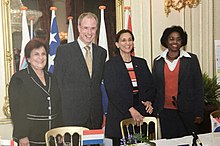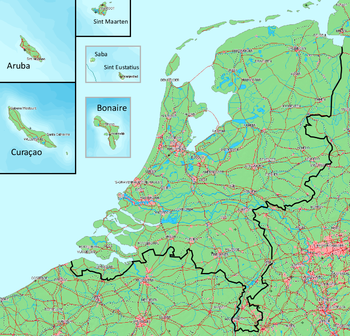Kingdom of the Netherlands
![]()
This article is about the existing kingdom. For the historical state, see Kingdom of the United Netherlands.
Template:Infobox State/Maintenance/NAME-German
The Kingdom of the Netherlands, Dutch Koninkrijk der Nederlanden, English Kingdom of the Netherlands, Frisian Keninkryk fan de Nederlannen, in Papiamento Reino Hulandes, is a state in Europe and the Caribbean. The state is divided into four parts called "Länder" (Dutch: landen). Each of the four countries belonging to the Kingdom is autonomous and has its own government and currency. Common tasks of the Kingdom consist mainly in foreign and security policy and in matters of nationality.
The four countries are:
- The Netherlands, with most of the state territory in Europe, but since 2010 also including three Caribbean islands, the "special municipalities" called the Caribbean Netherlands or BES-eilanden (BES islands): Bonaire, Sint Eustatius and Saba;
- Aruba, land in the Caribbean;
- Curaçao, country in the Caribbean;
- Sint Maarten, country in the Caribbean.
The kingdom emerged in this form from the colonial empire of the Netherlands. After Indonesia's independence in 1949, this still included Suriname in South America as well as the Caribbean islands, which were then grouped together as the Netherlands Antilles. Suriname became independent in 1975, while the Netherlands Antilles were dissolved in 2010 (Aruba became an independent country in 1986).
The legal basis for the Kingdom is the Constitution of the Netherlands and, since 1954, the Statuut voor het Koninkrijk der Nederlanden. The latter regulates relations between the four countries and joint decision-making. The three countries in the Caribbean also have their own constitutions, which in all three countries are called Staatsregeling.
The Kingdom has as a common body the Rijksministerraad. This is the Dutch cabinet, augmented by representatives from the other three countries. Joint laws are passed by the Dutch Parliament after hearing Caribbean representatives. The head of state of the Kingdom and of each country is the King of the Netherlands.
The European country of the Netherlands sees itself as a decentralized unitary state because governmental functions have been devolved to lower levels (such as the provinces). There is no generally accepted classification for the Kingdom as a construction of four countries. Constitutional historian Tijn Kortmann called the Kingdom a federation, but of a very unique kind.
History
Prehistory and statute 1954
→ Main article: Dutch colonies
Since the 17th century, the Netherlands had colonies in other parts of the world. After the Second World War, a rapid decolonization of most of these territories took place. Under political pressure from the United Nations and the United States, the Netherlands released the country of Indonesia into sovereignty as a separate state. A loose Dutch Indonesian Union still existed until 1954, but it broke up over the dispute over New Guinea. New Guinea remained under Dutch administration for a few more years. Suriname and the Netherlands Antilles also remained Dutch.
With the Netherlands Antilles and Suriname it was possible to reach an agreement on a new construction of the kingdom. Autonomy and equal rights for the overseas territories were guaranteed. In 1954, relations between the Netherlands, Suriname, the Netherlands Antilles and New Guinea were regulated by the entry into force of the Statute of the Kingdom of the Netherlands. Suriname and the Netherlands Antilles became countries of the Kingdom and were granted internal autonomy.
In 1962, New Guinea came under United Nations administration and was handed over to Indonesia in 1963. Suriname seceded from the Kingdom on 25 November 1975 and became an independent republic. From that date, the Kingdom of the Netherlands consisted of only two countries.
In 1986 Aruba, until then a part of the Netherlands Antilles, got the status of a separate country within the Kingdom. Since then, the Kingdom consisted of three countries until 2010. When Aruba received its "status aparte", the statute of the kingdom provided that it should leave the kingdom in 1992 and thus become independent. However, this plan was dropped.
On 10 October 2010, the rest of the Netherlands Antilles was finally dissolved, making Curaçao and Sint Maarten autonomous countries within the Kingdom, and the islands of Bonaire, Saba and Sint Eustatius joined the Netherlands as special municipalities.
Reform from 2010
In earlier years, the Kingdom Statute was increasingly felt to be out of date. It was therefore to be redesigned. Referendums had been held on all the islands of the Netherlands Antilles. The island territories of Sint Maarten and Curaçao wanted to obtain a status aparte (a special status) like Aruba and thus become independent countries within the Kingdom. The populations of Bonaire and Saba were in favour of annexation to the European Netherlands (and would thus become EU citizens), whereas only the population of the island of St. Eustatius wanted to remain part of the Netherlands Antilles.
On 15 December 2008, Kingdom Day, an agreement on the dissolution of the Netherlands Antilles was signed during a round table conference in Curaçao. The final restructuring was finally implemented on 10 October 2010 and the State Union of the Netherlands Antilles was abolished. Curaçao and Sint Maarten have since belonged to the Kingdom as new autonomous countries, comparable to the status of Aruba.
The islands of Bonaire, St. Eustatius and Saba received a new status as "special municipalities" (bijzondere gemeenten) within the Netherlands, without belonging to a Dutch province. Each of these three islands has a gezaghebber (comparable to a mayor), a bestuurscollege and an eilandsraad. These three islands are often collectively called BES-eilanden, after the initial letters. Officially, however, the term Caribbean Netherlands (Caribisch Nederland) is used; this is not to be confused with the Dutch Caribbean, by which all islands are meant (the three countries as well as the BES-eilanden).
The BES-eilanden initially retained Antillian laws, but must gradually adopt Dutch laws. This is a contentious issue, especially on issues such as gay marriage or euthanasia. In 2011, Dutch education laws were adopted, although the foreign language German, for example, was replaced by Spanish. Already since 2008 there is the Rijksdienst Caribisch Nederland, which represents the Dutch state on these islands. It reports to the Dutch Ministry of the Interior and Kingdom Relations.
| Area | Part of the Kingdom before 10 October 2010 | Part of the Kingdom since 10 October 2010 |
| Netherlands (European territory) | Netherlands | Netherlands |
| BES Islands (Bonaire, Sint Eustatius and Saba) | Netherlands Antilles | |
| Curaçao | Curaçao | |
| SintMaarten | Sint Maarten | |
| Aruba | Aruba | Aruba |

From left to right: Emily de Jongh-Elhage (Prime Minister of the Netherlands Antilles), Atzo Nicolai (Minister of Foreign Affairs of the Netherlands), Sarah Wescot-Williams (Prime Minister of Sint Maarten) and Zita Jesus-Leito (Member of the States of the Antilles), in November 2006 in The Hague at the conclusion of the negotiations.
Countries of the Kingdom
The kingdom has a total population of around 16.87 million people and a population density of 397 inhabitants/km². In the European part, the population density is only slightly higher with 399 inhabitants/km².
The European Netherlands borders Germany and Belgium. Of the Caribbean islands, only Sint Maarten has a border with another state: more precisely, this country is located on the island of St. Martin, which is also home to a French overseas territory, Saint-Martin
Geographically, the islands in the Caribbean are divided into two groups:
- The so-called ABC islands (Aruba, Bonaire and Curaçao) are located off the South American coast, opposite Venezuela. They belong to the Leeward Islands, which in turn are part of the Lesser Antilles.
- The so-called SSS islands (Sint Eustatius, Saba, Sint Maarten) lie further north and also belong to the Lesser Antilles, but to the Windward Islands.
The highest elevation in the Kingdom is the volcano Mount Scenery on Saba, one of the BES islands, at 887 metres. In the European Netherlands, the Vaalserberg (323 metres) is the highest.
Throughout the Kingdom, Dutch is the official language. In the Caribbean, Papiamento (also: Papiamentu) is often spoken. This is a creole language that originated from Spanish, Portuguese, Dutch and other influences.
| Kingdom part | Location | Population | Area | Population density | Currency | Official languages; other | |
| Netherlands | Europees Nederland |
| 16.570.613 | 41,526 km² | 399 Ew/km² | Euro (EUR) | Dutch; Frisian |
| Caribbean Netherlands (BES Islands) | 18.401 | 322 km² | 57 Ew/km² | US dollar (USD) | Dutch; English, Spanish | ||
| Aruba |
| 106.050 | 180 km² | 589 Ew/km² | Aruba-Florin (AWG) | Dutch, Papiamento; Spanish, English | |
| Curaçao |
| 142.180 | 444 km² | 320 Ew/km² | Antillean guilder (ANG) | Papiamento, Dutch, English; Spanish | |
| Sint Maarten |
| 33.119 | 34 km² | 974 Ew/km² | Antillean guilder (ANG) | Dutch, English; Spanish, local Creole | |

Map with the countries in the same scale
Questions and Answers
Q: What is the Kingdom of the Netherlands?
A: The Kingdom of the Netherlands is a transcontinental sovereign state whose form of government is a constitutional monarchy.
Q: When was the country formed?
A: The country was formed in 1954.
Q: How many countries make up the Kingdom of the Netherlands?
A: The Kingdom of the Netherlands is made up of four countries.
Q: What are the names of the European country and the Caribbean islands that make up the Kingdom of the Netherlands?
A: The European country is called the Netherlands, and the Caribbean islands are Aruba, Curaçao, Sint Maarten, Bonaire, Saba, and Sint Eustatius.
Q: What are the Caribbean Netherlands?
A: The Caribbean Netherlands are special municipalities ('public body') of the Netherlands and consist of Bonaire, Saba, and Sint Eustatius.
Q: What happened to the Netherlands Antilles?
A: The Netherlands Antilles doesn't exist anymore and were made up of the six above-mentioned Caribbean islands.
Q: Was Suriname a part of the Kingdom of the Netherlands?
A: Yes, Suriname was part of the Kingdom until it became independent in 1975.
Search within the encyclopedia
_in_the_Kingdom_of_the_Netherlands.svg.png)


